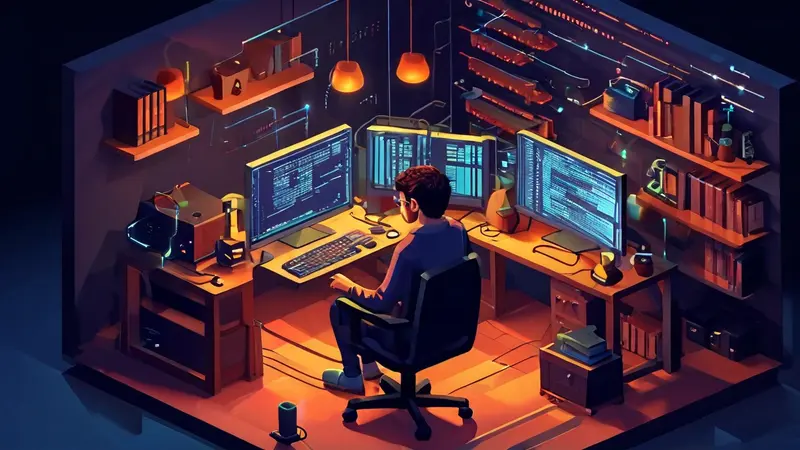
Visual programming is commonly abbreviated as VP. One of the significant aspects of VP is its ability to facilitate program development through the manipulation of program elements graphically rather than textually. By visually structuring the flow of operations or data, it enables developers, including those without deep coding expertise, to construct programs more intuitively.
I. INTRODUCTION TO VISUAL PROGRAMMING
Visual programming is a paradigm shift from traditional text-based programming, offering a unique approach to software development. Visual programming languages (VPLs) use graphical elements like icons and connectors to represent concepts and actions, simplifying the programming process. This approach is particularly beneficial for educational purposes and rapid prototyping. VP also bridges the gap between user interface design and functionality coding, providing a cohesive development experience.
II. ADVANTAGES OF VISUAL PROGRAMMING
The benefits of visual programming are manifold. For one, it improves comprehension by representing complex processes with visual metaphors. Accessibility is another significant advantage; it opens up programming to a broader audience, including those who may find traditional coding daunting. Furthermore, it accelerates development timelines through rapid prototyping capabilities and visual debugging tools that make it easier to identify and rectify errors.
III. POPULAR VISUAL PROGRAMMING TOOLS
Several visual programming tools have gained widespread popularity due to their effectiveness and user-friendly interfaces. For instance, Node-RED enables users to wire together devices, APIs, and online services with ease. Scratch, developed by MIT, introduces children to programming concepts without writing code. LabVIEW is a system-design platform and development environment, widely used in engineering applications for testing, measurement, and control systems.
IV. VISUAL PROGRAMMING IN EDUCATION
Incorporating visual programming in educational environments profoundly impacts the learning process. It helps students grasp fundamental programming concepts and logic without getting entangled in syntax errors. Educational VPLs like Scratch and Alice are designed to be engaging and interactive, fostering creativity, systematic reasoning, and problem-solving skills among young learners.
V. CHALLENGES AND CRITICISMS
Despite its benefits, visual programming faces certain challenges and criticisms. A common critique is that it may oversimplify programming, potentially leading to limitations in flexibility and control compared to text-based languages. Complex projects might also result in cluttered visual representations, making it harder to manage and understand the program structure. However, ongoing advancements in VP aim to overcome these hurdles.
VI. THE FUTURE OF VISUAL PROGRAMMING
The future of visual programming looks promising with continuous improvements and new tools emerging. Integrations with augmented reality (AR) and virtual reality (VR) are being explored to further enhance the programming experience. The focus is on developing more sophisticated VPLs that can handle complex tasks while still offering the simplicity that makes visual programming appealing.
In conclusion, visual programming represents a stride toward making programming more accessible and intuitive. Through the use of visual elements, it simplifies the coding process, making it possible for people from diverse backgrounds to participate in software development. Despite some criticisms, the evolution of VP continues to address its shortcomings, indicating a robust potential for the field's growth and integration into more advanced technological arenas.
相关问答FAQs:
Q: What is the abbreviation for Visual Programming in English?
A: The abbreviation for Visual Programming in English is "VP". This term is commonly used in the field of computer science and software development to refer to the process of creating software programs using visual elements and graphical user interfaces. Visual Programming allows developers to design and develop applications by manipulating visual elements, such as icons, buttons, and connections, instead of writing traditional lines of code.
Q: How does Visual Programming work?
A: Visual Programming is a programming paradigm that enables developers to create software applications by manipulating visual elements and graphical representations, rather than writing lines of code. In a Visual Programming environment, developers typically use a visual programming language or a drag-and-drop interface to design and develop their applications. They can use pre-built components or blocks and connect them together to create the desired functionality. The visual interface allows developers to easily understand and modify the program's structure, making it more accessible for beginners and non-technical users.
Q: What are the advantages of Visual Programming?
A: Visual Programming offers several advantages over traditional text-based programming languages:
-
Ease of use: Visual Programming allows users to create programs using a visual interface, which is often more intuitive and easier to understand compared to writing lines of code. This makes it a great option for beginners and those with little or no programming experience.
-
Rapid prototyping: With Visual Programming, developers can quickly create prototypes and mock-ups of software applications. This allows for faster iteration and feedback, reducing the time and effort required to develop a fully functional software product.
-
Debugging and error handling: Visual Programming environments usually provide visual feedback and error checks in real-time, making it easier for developers to identify and fix issues in their code. This can significantly streamline the debugging process and improve overall productivity.
-
Collaboration and teamwork: Visual Programming often supports collaboration and teamwork by allowing multiple developers to work on the same project simultaneously. This promotes knowledge sharing, increases efficiency, and enhances the overall quality of the software.
-
Accessibility: Visual Programming can make programming more accessible to a wider range of users, including those with disabilities or cognitive impairments. The visual nature of the programming interface removes barriers and provides alternative ways to interact with the code.
In conclusion, Visual Programming offers a more visual and intuitive approach to software development, making it easier for beginners to learn and understand programming concepts. It promotes faster prototyping, streamlines the debugging process, facilitates collaboration, and improves accessibility.
文章标题:视觉编程英文简称叫什么,发布者:worktile,转载请注明出处:https://worktile.com/kb/p/2056538

 微信扫一扫
微信扫一扫  支付宝扫一扫
支付宝扫一扫 